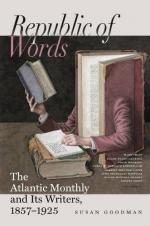This first essay of his poetic powers exhibits the foundation upon which his later life was built. The figure of Beatrice, which appears veiled under the allegory, and indistinct in the bright cloud of the mysticism of the “Divina Commedia,” takes her place in life and on the earth through the “Vita Nuova,” as definitely as Dante himself. She is no allegorized piece of humanity, no impersonation of attributes, but an actual woman,—beautiful, modest, gentle, with companions only less beautiful than herself,—the most delightful figure in the midst of the picturesque life of Florence. She is seen smiling and weeping, walking with stately maidenly decorum in the street, praying at the church, merry at festivals, mourning at funerals; and her smiles and tears, her gentleness, her reserve, all the sweet qualities of her life, and the peace of her death, are told of with such tenderness and refinement, such pathetic melancholy, such delicate purity, and such passionate vehemence, that she remains and will always remain the loveliest and most womanly woman of the Middle Ages,—at once absolutely real and truly ideal.
It was in the year 1292, about two years after the death of Beatrice, and when he himself was about twenty-seven years old, that Dante collected into this libretto d’ amore the poems that he had written during Beatrice’s life, adding to them others relating to her written after her death, and accompanying all with a narrative and commentary in prose. The meaning of the name which he gave to the book, “La Vita Nuova,” has been the cause of elaborate discussion among the Italian commentators. Literally “The New Life,” it has been questioned whether this phrase meant simply early life, or life made new by the first experience and lasting influence of love. The latter interpretation seems the most appropriate to Dante’s turn of mind and to his condition of feeling at the time when the little book appeared. To him it was the record of that life which the presence of Beatrice had made new.[3]
But whatever be the true significance of the title, this “New Life” is full not only of the youthfulness of its author, but of the fresh and youthful spirit of the time. Italy, after going through a long period of childhood, was now becoming conscious of the powers of maturity. Society, (to borrow a fine figure from Lamennais,) like a river, which, long lost in marshes, had at length regained its channel, after stagnating for centuries, was now again rapidly advancing. Throughout Italy there was a morning




